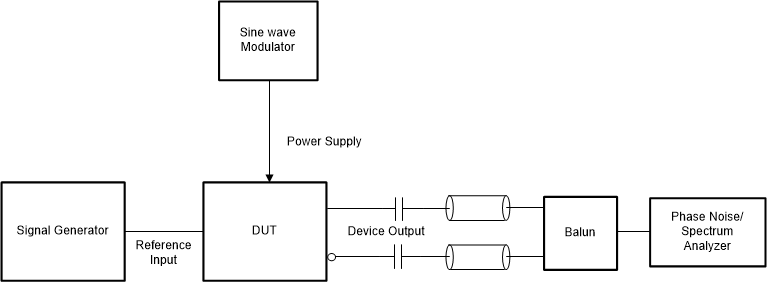ZHCSN15B June 2020 – June 2021 LMK05318B
PRODUCTION DATA
- 1 特性
- 2 应用
- 3 说明
- 4 Revision History
- 5 说明(续)
- 6 Pin Configuration and Functions
- 7 Specifications
- 8 Parameter Measurement Information
-
9 Detailed Description
- 9.1 Overview
- 9.2 Functional Block Diagram
- 9.3
Feature Description
- 9.3.1 Oscillator Input (XO_P/N)
- 9.3.2 Reference Inputs (PRIREF_P/N and SECREF_P/N)
- 9.3.3 Clock Input Interfacing and Termination
- 9.3.4 Reference Input Mux Selection
- 9.3.5 Hitless Switching
- 9.3.6 Gapped Clock Support on Reference Inputs
- 9.3.7 Input Clock and PLL Monitoring, Status, and Interrupts
- 9.3.8
PLL Relationships
- 9.3.8.1 PLL Frequency Relationships
- 9.3.8.2 Analog PLLs (APLL1, APLL2)
- 9.3.8.3 APLL Reference Paths
- 9.3.8.4 APLL Phase Frequency Detector (PFD) and Charge Pump
- 9.3.8.5 APLL Feedback Divider Paths
- 9.3.8.6 APLL Loop Filters (LF1, LF2)
- 9.3.8.7 APLL Voltage Controlled Oscillators (VCO1, VCO2)
- 9.3.8.8 APLL VCO Clock Distribution Paths (P1, P2)
- 9.3.8.9 DPLL Reference (R) Divider Paths
- 9.3.8.10 DPLL Time-to-Digital Converter (TDC)
- 9.3.8.11 DPLL Loop Filter (DLF)
- 9.3.8.12 DPLL Feedback (FB) Divider Path
- 9.3.9 Output Clock Distribution
- 9.3.10 Output Channel Muxes
- 9.3.11 Output Dividers (OD)
- 9.3.12 Clock Outputs (OUTx_P/N)
- 9.3.13 Glitchless Output Clock Start-Up
- 9.3.14 Clock Output Interfacing and Termination
- 9.3.15 Output Synchronization (SYNC)
- 9.3.16 Zero-Delay Mode (ZDM) Synchronization for 1-PPS Input and Output
- 9.4 Device Functional Modes
- 9.5 Programming
- 10Application and Implementation
- 11Power Supply Recommendations
- 12Layout
- 13Device and Documentation Support
- 14Mechanical, Packaging, and Orderable Information
8.1 Output Clock Test Configurations
 Figure 8-1 LVCMOS Output Test Configuration
Figure 8-1 LVCMOS Output Test Configuration Figure 8-2 LVCMOS Output Phase Noise Test Configuration
Figure 8-2 LVCMOS Output Phase Noise Test Configuration Figure 8-3 AC-LVPECL, AC-LVDS, AC-CML Output AC Test Configuration
Figure 8-3 AC-LVPECL, AC-LVDS, AC-CML Output AC Test Configuration Figure 8-4 AC-LVPECL, AC-LVDS, AC-CML Output Phase Noise Test Configuration
Figure 8-4 AC-LVPECL, AC-LVDS, AC-CML Output Phase Noise Test Configuration Figure 8-5 HCSL Output Test Configuration
Figure 8-5 HCSL Output Test Configuration Figure 8-6 HCSL Output Phase Noise Test Configuration
Figure 8-6 HCSL Output Phase Noise Test Configuration
Single-sideband spur level measured in dBc with a known noise amplitude and frequency injected onto the device power supply.
Figure 8-7 Power Supply Noise Rejection (PSNR) Test Configuration